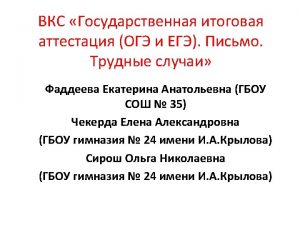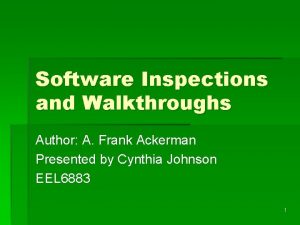WALKTHROUGHS Testing How do you know your design















- Slides: 15

WALKTHROUGHS

Testing How do you know your design worked? What does it take for it to be said to work?

Test plan Data What you expected What actually happened

Example

Example Data Expected display What actually happened Age entered 0 Not a teenager Do you want enter a new age Age entered 1 Not a teenager Do you want enter a new age Age entered A Error Depends on the machine Age entered 13 Might be a teenager Is a teenager Age entered 20 Might be a teenager Is a teenager Might be a teenager

Use the data to go through the design The data should test events that were not part of the original specification as well. In this module case if you find any of these note them down if you can not find a solution.

Give your design and test data to others to run through and test.

Walkthrough - manual Low-tech, but very useful and powerful technique. Easy method Print out copies of the design/code. Move away from the computer. Read through the code and with pen and paper simulate what is going on. At each step keep a record of how variables and data changes.

Walkthrough-verbal Explain what your code does to somebody else. The other person you explain the code to might spot the error. The action of putting into words what the code should do.

Inspection Walkthrough is generally the designer/programmer going through their own code, acting as the computer and finding the errors and noting down them.

Inspection You should always do this. Inspections are some respects a formalised version. Various forms of these. Usually takes the form of a meeting, and people take on roles.

Roles You can create meeting to use these techniques where everybody has a role. Some possible ones of these are included below Designer – The designer/programmer of the routine under test. Usually does not say much in the meeting.

Roles Tester/Inspected – person going through a finding whether it works or not. Reader-person who literally reads out the design or line of code at the appropriate point. Note taker – noting down the results – its very important to note down the results, comments, etc.

Roles This is not a definitive list, make-up, names, etc vary. Sometimes the names change, or roles are combined. Avoid having the designer and the inspector being the same person. The idea behind the process though is essentially the same: Make a project ‘ego-free’: The project is a group activity not a solo activity of the designer. To find the faults/problems early in the process before it goes outside of the project group.

Task In groups of three, take the ‘is a teenager’ task, tip task and wall-follower routine and each have a go at been: The designer/reader – person who wrote the solution reads out the steps of their solution. The inspector/tester – takes those steps and performs/tests them. Commenting on any problems. Note-taker: Notes down the comments. So at the end the group can make recommendations.
 Walkthroughs in software testing
Walkthroughs in software testing Instructional walkthroughs
Instructional walkthroughs Pms vs pregnancy
Pms vs pregnancy Happpy nod
Happpy nod Put your right foot in put your right foot out
Put your right foot in put your right foot out I know you had your birthday yesterday
I know you had your birthday yesterday 1 corinthians 3:16-17, 6:19
1 corinthians 3:16-17, 6:19 How to know if your growth plates have closed
How to know if your growth plates have closed Know history know self
Know history know self Dilan gorur
Dilan gorur I'm holding on to your promises you are faithful
I'm holding on to your promises you are faithful Do you love the rain
Do you love the rain Do you know minecraft
Do you know minecraft You're a poet and you don't know it
You're a poet and you don't know it When you're blue and you don't know
When you're blue and you don't know Do asexual people have sex
Do asexual people have sex





























